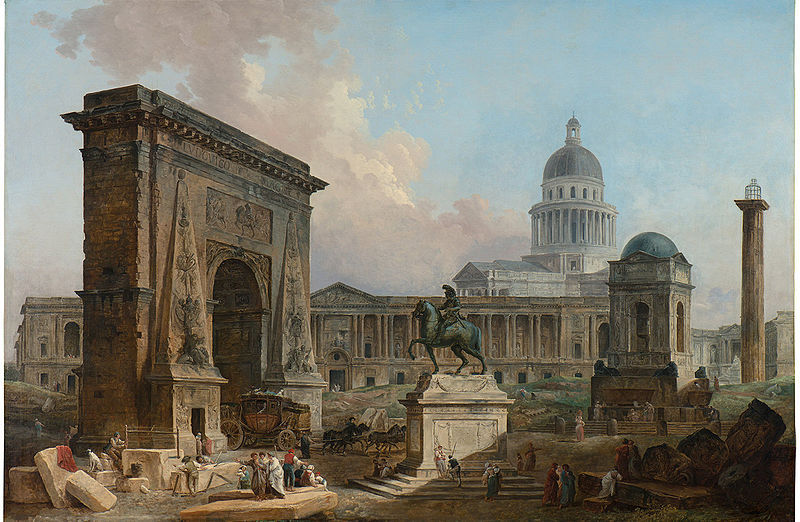Robert’s Interest in French Classical Antiquity
On his return to Paris in 1765, Robert drew upon his time in Italy for his newer paintings and embarked on a project to depict French classical antiquity with the same vigor and detail he used on his capricci, paintings depicting fictitious landscapes featuring classical ruins, while in Rome. The artist became especially interested in the city planning and renovations that took place in Paris from 1786 to 18091. Many of these renovations were carried out in order to improve the flow of traffic from the Left Bank to the Right Bank. New bridge construction, including that of the Pont-au-Change and Pont-Marie, and the demolition of older buildings, offered new sweeping views of the city. Urban spaces were transformed and Robert capitalized on the opportunity to explore the application of the capriccio style on the modern city.
Exhibited at the Salon of 1789, Monuments of Paris is a painted view of numerous famous Parisian sites geographically unrelated to one another, fit into a single space. This painting is a continuation of Robert’s previous capricci. Robert disregards exact proportions and measurements of the monuments, prioritizing the juxtaposition of the sites and architectural relations to each other. Like the stable and grounded essence of Roman arches and cathedrals, Robert’s depiction of monuments like the Porte Saint-Denis and the Fontaine des Quatre Saisons, harkens back to the timelessness of classical ruins. Miniature human figures are scattered amongst the foreground, dressed in both classical and modern attire. At the time this was painted, a few structures in Robert’s painting were unfinished: the Louvre colonnade and the dome of Saint-Genevieve2. The monuments are situated in a location reminiscent of archaeological sites, as the painting has washes of brown and grays.
In the face of modernity and a changing Parisian cityscape, Robert remains interested in the architecture of the ancient and how those structures operate in a new era. Applying the capriccio style and adapting it to depict Parisian sites, Robert demonstrates the enduring presence of classical antiquity in the formation of the newly transformed city.
______________________________________________________________________________
1 Dubin, Nina L. “Anti-edifice.” Futures & Ruins: Eighteenth-Century Paris and the Art of Hubert Robert. Los Angeles: Getty Research Institute, 2010, 109
2Ibid., 111
